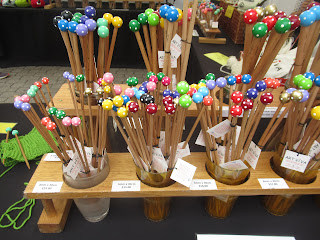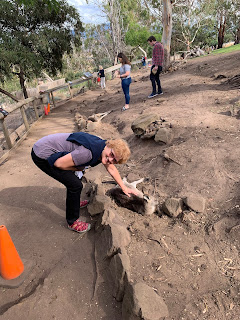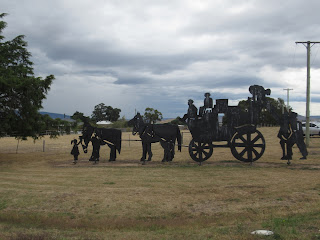I am simultaneously finishing a travel blog about the fantastic 4.5 month long trip Steven and I took last fall and early winter to Armenia, Georgia, Azerbaijan, and much of Central Asia before our final six weeks in Spain and Portugal and a few days in the Netherlands. If you're interested in checking that exciting adventure out, here's the link: www.bergersadventures6.blogspot.com
Diane and I'd just spent our last night in Tasmania at the Orana House B&B in Hobart which seemed idyllic from having read lots of reviews and from the pictures below. However, never have I stayed at a hotel, hostel, let alone a B&B, where we saw no sign of any owners or any staff when checking in or checking out - the only staff member was at breakfast!
Since this was our last day of our 3.5 week-long trip to New Zealand and a small part of Australia, Diane and I both really wanted to remember our great time together and buy at least one souvenir at the Saturday Market at Salamanca Place. I'd read it would be the perfect place to buy items made from Tasmanian timber and particularly Huon pine.
At Bonorong, which meant 'native companion,' most of the animals had been rescued after being injured because the owner was passionate about saving and conserving indigenous creatures.
Diane and I'd made sure to reach the sanctuary before a tour at 11:30 so we'd have enough time to see kangaroos roaming free. Having seen too many as roadkill just on our short time in Tasmania, it was reassuring seeing and being able to interact with live ones. These were very tame, allowing people to pet them seeing totally unconcerned.
I'm guessing we've all heard about the manic Tasmanian devil character from Bugs Bunny cartoons! They were one of the main reasons we chose to stop at Bonorong. The enclosure where the Tasmanian devil was kept was fitted with a bungee cord with food attached as the 'tug of war' that enabled it to get food. I learned it mimicked the natural tug of war that occurs among multiple devils at a carcass in the wild.
A sign indicated that cardboard boxes, ropes and toilet rolls in the enclosure weren't garbage but for stimulation and play. I don't know whether it was normal behavior or because the devils were in captivity but it was very strange eyeing the devil literally run around in circles for several minutes at pretty fast speeds.
One of the biggest draws at the sanctuary was seeing the koalas even though they don't live in the wild in Tasmania. Bonorong only had three of them because it used to be a zoo which always had koalas. Elspeth mentioned the koalas live for 20 years in captivity and these ones will remain here until they die because they can't be sent back to the mainland or to live in the wild.
Koalas, who get all the water they need from the leaves, have no predators large enough to grab them out of the tree. Their brains are only the size of a walnut!
Across from the conservation area was Callington Mill, the only authentic, working 19th century flower mill in the Southern Hemisphere. It was restored to full working order in 2010. Local farmers grow grains suited to the area and the mill, just as they did in the days of early settlement.
If Steven and I were ever to visit Tasmania together, I would definitely recommend we spend more time in the central part of the island state as there was far more to see than Diane and I had time for in our quick jaunt over from the mainland.
The city's newspaper building dated from 1842 and had an interesting facade.
Diane and I'd just spent our last night in Tasmania at the Orana House B&B in Hobart which seemed idyllic from having read lots of reviews and from the pictures below. However, never have I stayed at a hotel, hostel, let alone a B&B, where we saw no sign of any owners or any staff when checking in or checking out - the only staff member was at breakfast!
What would a market be in Australia be without Uggs being represented?!
Just like at most markets Steven and I've been to in the US, there was a great cross section of people, from hippies to families to obviously people of a certain means which made people watching almost as much fun as looking at the products for sale!
Since we're all such avid knitters, Suellen and Janina, I was tempted to buy the snazzy Tasmanian oak knitting needles.
There was a large number of stalls selling leather items, soaps and products made from Huon pine but, except for a paltry magnet, nothing shouted out at us to buy. I thought the prices were significantly higher, too, for comparable items at craft fairs back home.
Before flying back to Melbourne from Launceston in northern Tasmania later that afternoon, we drove toward Bonorong Wildlife Sanctuary, the island's most popular wildlife park located in the center of the island.
The entrance to Bonorong Wildlife Sanctuary grabbed us right away!
Now these chain link bathroom doors at the sanctuary were sure different!
Diane and I'd made sure to reach the sanctuary before a tour at 11:30 so we'd have enough time to see kangaroos roaming free. Having seen too many as roadkill just on our short time in Tasmania, it was reassuring seeing and being able to interact with live ones. These were very tame, allowing people to pet them seeing totally unconcerned.
Entry included a free bag of kangaroo food but when Diane and I tried to feed them, they weren't interested in the slightest. We must have arrived well after other visitors had already fed them!
The guide, Elspeth, told us that all animals at the sanctuary were here because they had been injured and couldn't go back to the wild. She added that there is also a breeding program at Bonorong. Elspeth mentioned the sanctuary tries to save every devil that is brought there. The devils live just just three years in the wild and eat 40 percent of their body weight in 30-minute segments. They are referred to as scavenger animals or opportunistic eaters. The guide threw meat out into the enclosure to lure the devil out of the burrow.
A joey is a marsupial like a kangaroo. Elspeth said the oldest one ever was 85 and lived at the sanctuary. A joey can live in its dead mum's pouch for five days so people were encouraged to move a dead adult joey from the road so the babies don't become secondary roadkill. As Tasmania is known as the roadkill capital of the world, the devils are fed 'recycled meals.' Elspeth cautioned people to be mindful to drive slowly at night to reduce the amount of roadkill.
The devils flourished on the island because it had no predators and became one of the island's mascots. Now though, the devil population is in desperate trouble because the animals have been afflicted by a deadly cancer known as Deadly Facial Tumor Disease which has decimated the wild population by an estimated 90 percent in some areas. Scientists fear that it may soon wipe out the wild population entirely. Some healthy devils, though, are being captured and relocated to preserve the species from extinction. It's such a contagious disease that experts have come from all over the world to come to find a cure. Three devils with the disease have been treated with a vaccine and recovered.
Devils can only run as fast as a chicken but they have a great sense of smell up to two kms away. Its jaw is so strong it will eat everything. This devil came in because its mother was infected by the facial disease and couldn't eat. Devils have such poor eyesight that Elspeth put her shoe out front so the devil wouldn't climb up her leg. It squealed nonstop in such a ferocious manner I was glad we weren't in the enclosure!
Though the sanctuary animals were obviously held captive, I couldn't have imagined a more natural looking environment for them to be living.
What a hoot it was when this emu popped its head over the low wall to look at us! I wonder what it thought of us.
I had never heard of the cute looking spotted-tail quoll before. They are called 'baby-faced assassins' because they are very agile climbers and strong enough hunters to target possum.
The large beak made the tawny frogmouth look quite ferocious but it's supposed to be a gentle creature. The frogmouth is known for often swooping in front of cars at night, hunting insects in front of the headlights. Unfortunately, many of the daredevils or brave birds are then hit and injured. That was why the birds ended up in the enclosure.
Koalas, who get all the water they need from the leaves, have no predators large enough to grab them out of the tree. Their brains are only the size of a walnut!
Koalas habitually sleep almost all day, not because they're lazy but because they eat food with almost zero energy content. With no need to chase their food as long as they sit on a branch with a good supply of fresh eucalyptus leaves, koalas have very little reason to be active. The leaves have so many toxins, it takes a koala's body so long to digest them. They're the only animals that like eucalyptus.
We were very fortunate that the koalas were wide awake when we were there and not sleeping as they're normally just awake 15-20 minutes at a time to eat. The koalas were passive and didn't appear to object to the crowd of people nearby or when we were allowed to approach one by one. I certainly never thought I'd be lucky enough to touch a koala!
The laughing kookaburra, often called the 'bushman's clock' and 'breakfast bird' because its famous laughing call is usually heard at dawn, lived up to its name and put on quite a show for us, cackling for a long time!
A koala's closest relation is the wombat who live in burrows that are 15 feet long. They also like to find a tree branch and roll up in a ball on its hard bottom. At the age of two, wombats like to find their own home as they are solitary animals.
When they are 'teenagers,' they get very nasty even to their own mum who then kicks them out! When wombats no longer tolerate Bonorong staff, they are moved to a big, gated grassy area in the bush. Wombats can run 40 mph over a short distance when attacked, according to Elspeth.
Millie came in the size of an orange as her mother had been killed on a highway as most wombats eat only at dusk and dawn. The now one-year old animal weighed 10 kilos and will grow to 20-40 kilos as an adult. Wombats have no natural predators and eat mostly root vegetables and chew things all the time.
Elspeth said she could go into the enclosure and pat Millie's hard bottom and she wouldn't likely move at all. That was certainly the case as Millie was very calm when she was paraded around allowing people to pat her on her bottom.
Randall the echidna was the last animal we saw at Bonorong Wildlife Sanctuary. Diane and I both felt that our experience there was one of the many highlights our trip 'down under.' Thanks to Elspeth, we learned a lot about Tasmania's native and other animals and had a really fun time doing it, too.
Leaving the sanctuary after noon, we drove north toward Launceston for our flight back to Melbourne, stopping in the 1821 historical village of Kempton in the hope of getting some lunch. The community was very appealing with several antique stores but there was no cafe or restaurant, only a tavern, to stop at.
The local distillery didn't fit the bill either at that time of the day, plus we weren't sure it was still open as there was a 'for sale' sign out front.
We had much better luck in the more thriving historic town of Oatlands that was full of attractive red sandstone buildings.
As Diane is a big coffee drinker, she got a kick out of this sign at the restaurant where we ate!
I'd never seen a place with so many film posters and memorabilia as in tiny Oatlands, so far from the Hollywood scene. It would have been the last place on God's green earth I might have expected it.
I had to admire Sylvester Stallone for refusing to sell the Rocky scrip for $350,000 despite having only $106 in his bank account and trying to sell his dog since he couldn't afford to feed it! The movie had a budget of $1 million and made $225 million in the box office.
More bathroom signs!
The Lake Dulverton Conservation Area in Oatlands was one of the few bodies of fresh water in a dry part of Tasmania and an important wildlife refuge.
These old cars seemed as aged as the original mill!
It rained cats and dogs on the Midland Highway all the way up to Launceston but it conveniently stopped just as we reached the city - were we relieved with that. We'd flown into the city several days ago but didn't spend the time then to see anything of the city, the commercial center of the northern region.
The city is known for its attractive late 19th century homes, historic mansions, and private gardens plus a lovely port along the Tamar River.
Can you imagine how much fun children would have playing at this nautically-themed playground in Royal Park!
Before walking to the city center, we spent some time along the waterfront, a very, very pretty area that would be an ideal spot to sit a spell if we had more than an hour before racing to the airport.
Custom House:
The Wool Growers' Building:
Launeceston's very impressive General Post Office and Clock Tower:
The Town Hall:
This was another stunning building in downtown Launceston that we only had time to admire as we passed by.
Diane got a little teary-eyed seeing the owl design as her late husband loved owls.
The Pilgrim Uniting Church had a lovely steeple.
The city's newspaper building dated from 1842 and had an interesting facade.
The Queen Victoria Art Gallery looked very appealing but would have to wait to visit until another time if possible.
Part of Civic Square:
Our 'down and dirty' walk of Launceston took just 45 minutes but gave us a sense of the pretty town that seemed to have a vibrant museum and arts scene located near beautiful farmland, vineyards and plenty of parks. Even though our visit was short and sweet, it was a nice way to bid adieu to Tasmania before returning to the mainland and home the next day.
Next post: A stop in Kansas City en route to Florida last month.
Posted on June 27th from Flagstaff where I just heard Steven and our sons safely climbed up the Grand Canyon - what a sigh of relief.































































































I love the tawny frogmouth bird. They sit still and look like tree bark. I hear the Koalas feel like a brillo pad, not soft like they look. I don't ever want to me a Tasmanian Devil in the wild. What teeth!! Janina
ReplyDeleteThe koala was adorable but yes, prickly, too. Seeing so many tassie devils as roadkill and then the ferocious live devils at Bonorong was enough for me, Janina!
DeleteWhere are my new "snazzy Tasmanian oak knitting needles"? Janina
ReplyDeleteWill a 8x10 glossy of them do?!!
ReplyDelete